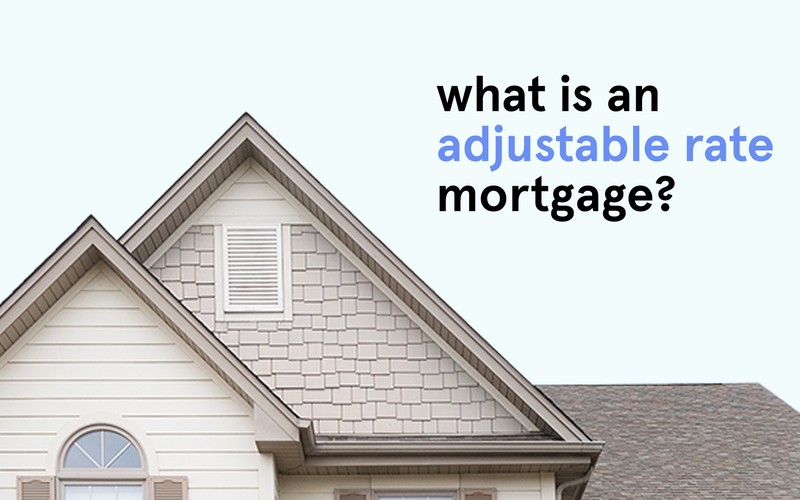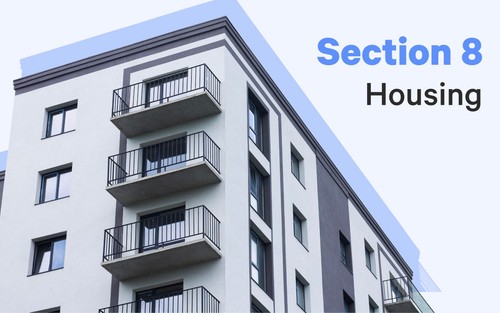Financing a home purchase is a big decision. There are several types of mortgages to consider. One of them is an adjustable-rate mortgage (ARM).
Here’s a quick guide to this type of mortgage. Use it to decide if an ARM is the best option to help you reach your financial goals.
What is an adjustable-rate mortgage?
An adjustable-rate mortgage is a home loan with an interest rate that adjusts over time based on the market.
Let’s break down what this means.
ARMs are a type of mortgage that typically starts with two periods: a fixed-rate period and an adjustable-rate period. That’s why they’re also called variable-rate mortgages or floating mortgages.
The interest rate for an ARM loan is reset based on a benchmark and an ARM margin.
During the fixed period, the interest rate doesn’t change. During the adjustment period, the interest rate can go up and down based on changes in the benchmark.
With ARM loans, borrowers incur more risk. As a result, it’s easier to qualify for an ARM than a traditional, fixed-rate loan. Moreover, ARM loans also often require lower down payments than traditional loans. They can be an excellent option for first-time homebuyers.
Types of adjustable-rate mortgages
There are three types of ARMs. They are hybrid, interest-only (IO), and payment options. Here’s a closer look at each type of ARM.
Hybrid ARM
A hybrid ARM is simply a mix of a fixed-rate mortgage and an adjustable-rate mortgage. With a hybrid ARM, the interest rate is fixed at the beginning of the loan. This initial fixed-rate period is followed by an adjustable-rate period. The date the interest rate changes from a fixed interest rate to an adjustable rate is called the reset date.
Lenders use two numbers to express the fixed and adjustable-rate periods. The first number indicates the length of the fixed rate period (usually number of years), and the second number indicates the adjustment frequency of the variable rate.
Let’s look at the 5/1 hybrid ARM as an example. It’s the most common type of hybrid ARM. It has an initial fixed-rate period of five years. After five years, the interest rate is adjusted every year.
Hybrid ARMs can have fixed-rate periods of three, five, seven, or ten years. After the reset date, the loans can be adjusted at nearly any interval. It all depends on the lender. However, the most common is to adjust the interest rate annually.
Interest-Only ARM
An interest-only adjustable-rate mortgage is a mortgage loan where borrowers must pay only the interest portion of the loan each month for a set period. This is called the interest-only period.
During the interest-only period, a borrower is not required to pay down any principal – just the interest accrued each period. It’s a way to help borrowers keep initial monthly mortgage payments low.
The duration of the interest-only period varies from lender to lender. Some last only a few months. Others can last several years. Mortgage amortization begins after the interest-only period ends.
Amortization is a financial term that refers to the process of paying off a home loan.
For borrowers, amortization on interest-only ARMs means their monthly mortgage payments significantly increase. These may be referred to as “balloon payments.”
Interest-only ARMs also have floating interest rates. That means the interest payment fluctuates month-to-month based on market conditions.
Because of the balloon payments and floating interest rates, interest-only ARMs can be risky. That’s why most borrowers refinance before the interest-only period ends.
Payment-Option ARM
A payment-option adjustable-rate mortgage is a type of ARM with several payment options for borrowers. They usually include payments that cover principal and interest, interest-only payments, or paying a minimum monthly payment.
Payment option ARMs might sound like a great option, but they come with a lot of risk and payment shock. Here’s why.
The minimum payment option is calculated a lot like a minimum payment option on a credit card. It’s based on an initial interest rate that is often lower. The minimum payment option goes towards interest, not principal or mortgage insurance. And, many times, it does not cover the full interest amount. As a result, deferred interest is created, and the loan amount increases. This is called negative amortization.
The monthly payments on payment option ARMs can increase for many reasons throughout the life of the loan. These include unscheduled interest rate adjustments when the borrower reaches their negative amortization limit, which can start a dangerous cycle.
Here’s how.
If the interest increases, the rate of negative amortization increases with each minimum payment made. This, in turn, increases the likelihood that the negative amortization rate will be reached and the mortgage will be recast. This can happen over and over throughout the loan term when borrowers aren’t careful.
This is what happened to many people during the mortgage crisis. Some lenders offered payment options ARMs to borrowers who could not qualify for other types of mortgages.
However, that doesn’t mean payment-option ARMs are bad. Many real estate investors use them to finance short-term investments, especially if they’re house-flipping.
How ARM rates are calculated
Many personal and economic factors influence mortgage rates, and ARMs are no different.
Personal factors influencing mortgage rates include your credit score, credit history, debt-to-income ratio, and employment.
Economic factors influencing mortgage rates include inflation, growth, the Fed, and housing market conditions. They are used to calculate interest rate benchmarks.
Lenders use a few accepted benchmarks. The one your lender uses will be listed in the ARM disclosures. The most common benchmarks are the London Interbank Offered Rate (LIBOR), the U.S. Treasury, and the Secured Overnight Finance Rate (SOFR).
LIBOR is a globally accepted benchmark interest rate used by major global banks in the international market for short-term loans. It was phased out at the end of 2021 for U.S. interest rates, but we’ve shared it here because some international banks still use it.
The U.S. Treasury debt is the benchmark used to price other domestic debt and set consumer interest rates in the United States.
SOFR is a benchmark set based on banks’ overnight borrowing costs. It’s based on U.S. Treasury repurchase agreements.
Benchmarks are essential for two reasons. First, they’re used to establish the fixed interest rate during the fixed period of the ARM. Second, they are the starting point for determining the variable rate during the adjustment period and any reset calculations.
Once the benchmark or index rate is established, the lender will calculate the mortgage rate margin. The margin refers to the number of percentage points added to the index, or benchmark, by the lender to set the interest rate on the ARM after the reset date. It’s established in the loan agreement and won’t change after closing unless otherwise stipulated.
The margin applied to an ARM depends on the borrower’s personal financial history. Creditworthy borrowers receive closer to the standard margin on mortgages. Borrowers with greater risk pay higher margins.
About interest rate caps
Fortunately, many lenders use rate caps. An interest rate cap limits how high an interest rate can rise on variable-rate debt, like an ARM.
There are two types of rate caps: periodic rate caps and lifetime rate caps. Periodic rate caps limit how much the interest rate can change year-over-year. A lifetime cap sets the limit on how much the interest rate can increase throughout the life of the loan.
It’s important to note that interest rate caps can increase over time.
Pros and cons of adjustable-rate mortgages
As with any mortgage, there are advantages and disadvantages to ARMs. Here’s a look at some of the biggest pros and cons of adjustable-rate mortgages.
Pros of ARMs
- Easier to qualify for than traditional fixed-rate loans: It’s true because the borrower incurs more risk with an ARM. As a result, they’re an excellent option for those with limited or poor credit history and first-time homebuyers.
- Lower initial payment amount: Adjustable-rate mortgages are a great tool to help borrowers unlock a lower interest rate during the fixed-rate period: this “teaser” or introductory rate results in predictable, lower upfront monthly mortgage payments.
- Flexibility for homeowners: ARMs can be an excellent option for anyone who plans to live in or own property for just a few years. It allows homeowners and real estate investors to take advantage of the low interest rate during the fixed-rate period and sell before the adjustable rate kicks in.
Cons of ARMs
- Unpredictable payments: Interest rates can fluctuate quite a bit over time. If the interest rate increases after the fixed-rate period, borrowers can face significantly increased mortgage payments after the reset period.
- Hard to predict the future: Fixed-rate mortgages make it easy for borrowers to budget and plan because they come with fixed interest rates and monthly mortgage payments throughout the loan’s lifetime. ARMs require careful financial planning to ensure borrowers can continue making their monthly payments.
- Complexity for borrowers: ARM disclosures can be hard to understand. They have complicated terms. Borrowers who don’t fully understand the rules, fees, and structure of ARMs can find themselves in a risky financial situation.
Is an adjustable-rate mortgage right for you?
It depends on your current financial situation as well as your financial goals.
ARMs can be a great choice for anyone who plans on keeping the loan for a limited time, is comfortable with the risk of rate increases, and can make ever-increasing mortgage payments.
The bottom line
Buying a home or investment property is a big financial decision. An adjustable-rate mortgage can be a great tool to help finance your purchase. ARMs offer access to the lowest possible interest rates, low initial monthly payments, and flexibility you don’t get with fixed-rate mortgages. However, they also come with unpredictable payments after the reset period, making them hard to plan and extremely complex.
If you’re ready to invest in real estate but don’t want the hassle of an ARM or any other type of loan, we can help.
With Arrived Homes, it’s easy to get started by purchasing shares in any of our rental properties for as little as $100, no matter your credit rating. To get started, browse through our available properties on this page.
The opinions expressed in this article are for general informational purposes only and are not intended to provide specific advice or recommendations for any individual or on any specific security or investment product. The views reflected in the commentary are subject to change at any time without notice. View Arrived’s disclaimers.







